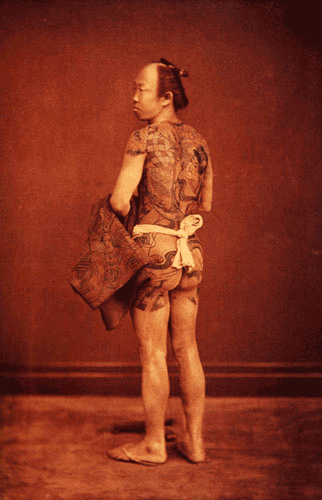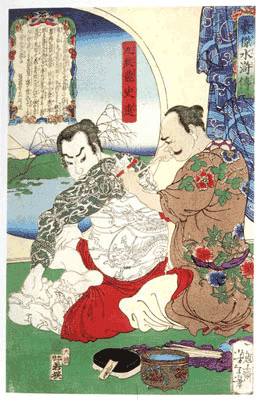|
Traditional Japanese Tattoo:
Horimono
|
Abstract 
Even though tattoos in Japan have for centuries been prohibited and
considered to be an entirely inappropriate practice for members of "decent"
society, the traditional Japanese tattoo, or horimono, flourished among
the common people of the late Edo period Japan (Rubin 121). Horimono
are full-body unified compositions that originated from the woodblock prints
of that period and were most often worn by laborers, manufacturers, merchants,
and hikeshi, or firemen (Kunihiro). Although not looked upon very
highly in Japanese society, horimono were - and still are - a beautiful
and intricate art form deeply woven into the culture of the common people
of the Edo period and is still practiced today.
Research
Report
Horimono were created by using bundled needles fixed to the end of a
bamboo rod and then dipped into ink and inserted into the skin by hand
in a technique known as tebori, literally "to carve by hand" ("Traditional").
The inks used to create horimono were made from natural materials, pressed
charcoal and cadmium. From the pressed charcoal ink they got black
and grey dye, and from the cadmium, an orange/red dye. Even though
the artists were so limited on colors they managed to create elegant and
complex horimono by emphasizing on shading (Miller 16).
The word tebori comes from the wood carvers who worked for Ukiyo-e
artists. The wood carvers were skilled craftsmen with great hand-eye
coordination and the delicate touch needed for carving woodcut blocks.
The Ukiyo-e artists would paint a design onto a block of wood and the wood
carvers would carve out the image to make a kind of wood block print.
These prints would be compiled into a series and used to illustrate stories.
Since the majority of income from an Ukiyo-e print series would be divided
between the artist and the writer, the carvers were considered merely a
service and despite the training, skill, and dedication required to be
a wood carver the job was very poorly paid ("Horimono"). As a consequence,
many carvers became tattoo artists instead where they could earn a week's
salary as a carver in one day of tattooing people. They simply exchanged
their woodcarving blades for long, sharp needles and ink (Schiffmacher
13). Thus the majority of the designs for horimono were based on
Ukiyo-e renditions of folklore, religion, and tradition.

To many scholars, Ukiyo-e is an art of a certain time and place: an
art of the lower classes of Edo in the Edo Period (1615-1868) (Kita 29).
The Ukiyo-e print occupied a very minor position in the hierarchy of the
Japanese arts (Rubin 130). The reason for this is because Ukiyo-e
was the first school of art in Japan to be composed almost entirely of
artists living on the mass sale of their work rather than by serving a
select clientele or a single patron. Because of this Ukiyo-e artists
were considered artisans and merchants. In the Confucian-influenced
social order of the Edo Period, artisans and merchants were at the bottom
of this system. They were treated as commoners, and Ukiyo-e was considered
the art of the oppressed lower classes (Kita 29).
Most scholars have associated the development of the horimono with a
very popular Chinese folk story Shui-hu Chuan [The Water Margin]
(Rubin 121). This story, translated as Suikoden in Japanese,
told the adventures of a band of 108 outlaws who, in fighting their oppressive
and corrupt rulers became folk heroes as protectors of the common people
(Sanders 12). By the late eighteenth century, this book was translated
into Japanese and illustrated with Ukiyo-e prints. At a time when
the ruling Samurai class had supreme and total authority over the people
-- including levying severe taxes and the right to kill commoners without
reprise -- the novel and its theme became increasingly popular among the
townspeople of Edo. In fact it became so popular that homegrown variations
of the Suikoden were published. The working classes of Edo
identified themselves with the heroes of the Suikoden, who were
oppressed but clung to the virtues of honor, courage, loyalty, and justice
("Horimono").
From the beginning of the nineteenth century, a phenomenally popular
version of Suikoden began to appear in Edo under the title Shinpen
Suiko Gaden [Newly compiled illustrated Suikoden]. Work
on this version began in 1805 and it was not completed until 1839.
The illustrations were drawn by the most prominent Ukiyo-e artist of the
time, Katsushika Hokusai (1760-1849). In addition to his illustrations
for this book, Hokusai also produced a separate volume of illustrations
of the Suikoden heroes called Ehon Suikoden in 1829.
Exploiting the current popularity of the Suikoden characters, another
Ukiyo-e artist, Utagawa Kuniyoshi (1797-1861), began to publish an immensely
popular series of prints called Tsuzoku Suikoden Goketsu Hyakuhachinin
no Hitori [108 Heroes of the Suikoden] in 1827 (Rubin 121).
Hokusai and Kuniyoshi were not the only Ukiyo-e artists who included the
tattoo in their work. A major compilation of Ukiyo-e prints with
tattooed figures includes work by artists such as Kunisada (1786-1864),
Yoshitoshi (1839-1892), Kunichika (1836-1900), and others (Rubin 122).
But it was specifically in the drawings by Kuniyoshi that some of the most
popular characters bore extensive body tattoos. For example, Shishin
wore an elaborate full-body tattoo of dragons, and Basho, who wore the
image of a fierce tiger on his back (Sanders 12).
Within a decade of Kuniyoshi's Suikoden series being published,
the popularity of horimono had increased to huge proportions, and working
class people such as laborers, carpenters, builders, river boatmen, market
traders, fishermen, messengers, workmen, and many others soon began to
imitate the heroes by sporting large body tattoos of their own. Because
the townspeople of Edo identified with the heroes and their trials and
tribulations so much, the horimono became a symbol of defiance and soon
grew to be a major part of their culture ("Horimono").
It was in the first decades of the nineteenth century that horimono
had its "golden age" (Rubin 124). The full-body tattoos were not
just seen in Ukiyo-e prints. Other cultural forms such as Kabuki
drama, and popular contemporary songs also often featured tattooed heroes
and anti-heroes. For example, the nineteenth century Edo Kabuki playwright,
Kawatake Mokuami, wrote some of the plays whose influence on horimono can
be seen today. His plays always featured working class people, thieves,
or rogues as the heroes and a large number of his characters wore horimono.
These stories really struck a chord with the audience of the time, and
are still popular today. The heroes from two of Kawatake's plays
in particular, Benten Kozo from Aotoz Oshihana no Nishikie, and Danshichi
Kurobei from Natsumatsuri Naniwa Kagami, are both tattooed and many people
wore designs based on these characters ("Horimono").
Horimono went on the decline with the end of the Edo Period and the
beginning of the modern period in 1868. This transition is referred
to by historians as the Meiji Restoration because it saw the end of the
feudal shogunal government and the restoration of the emperor as the head
of state. The Meiji Restoration, or the Meiji "Suppression" as far
as the tattoo world was concerned, was highly sensitive to the way Japan
was perceived by the Western powers. The new central government concluded
that tattooing would be seen as a sign of barbarism (Rubin 124).
Ukiyo-e, novels, drama and other art forms that featured horimono were
banned or suppressed. By 1880 the newly formed Tokyo Metropolitan
Police had clamped down severely on tattoo establishments and the number
of people with horimono greatly decreased ("Horimono"). The industry
was driven underground to survive and it was only with Japan's defeat in
August, 1945 and the subsequent establishment of the American Occupation
(until 1952), that many of the oppressive regulations and laws of the previous
government were overturned. Tattooing now became legal and the craftsmen
were allowed to practice their art without harassment (Rubin 124).
Historical
Significance
The technique that was used to make horimono over 150 years ago is still
employed today. The tattoo artists still use needles fixed to the
end of a bamboo rod, but the dye used now is much safer for one's skin
than it was before (Shaw). Although any form of tattooing is still
unacceptable in Japanese society, horimono has become quite popular among
people throughout the world interested in tattooing. Horimono enjoy
a very high reputation and are widely considered to be the most important
form of the art in the world (Schiffmacher 14).
Horimono is a beautiful art form, which flourished in the Edo period.
These intricate and meticulously detailed tattoos became a proud symbol
of the common people. Tattoos have been associated with organized
crime and "unclean" society, but these tattoos became the backdrop of a
culture, appearing in novels, Kabuki Theater and other forms of art.
Horimono became a source of pride and unity to those belabored by the rulers
of the Edo Period. They offer us a key to the understanding of the
culture of the common people during that time.
References
Kita, Sandy. "From shadow to substance: redefining ukiyo-e." The
floating world of ukiyo-e: shadows, dreams, and substance.
pp. 27- 79. Harry N. Abrams, Inc. New York: 2001.
Kunihiro, Shimada. "Brief history of the Japanese tattoo." Burst.
July 1998. Translated by Adam Guy.
Miller, Jean-Chris. A complete illustrated guide to tattoos,
piercings, and other body modifications. Berkley Book.
New York: 1997.
Rubin, Arnold. "Japan." Marks of Civilization.
pp. 92-133. Singapore: 1988.
Sanders, Clinton. Customizing the body: the art and culture
of tattooing. Temple University Press. Philadelphia:1998.
Schiffmacher, Henk. "A brief history of the tattoo." 1000
Tattoos. pp. 7-16. English translation, Deborah Ffoulkes.
Taschen. Koln, Germany:1996.
Web Resources
"Horimono: the traditional Japanese tattoo." On-line. Internet.
10 April 2002.
Available URL: http://www.horimono.net.
Shaw, Jonathan. "Japan's living tattoo tradition." On-line.
Internet. 10 April 2002.
Available URL: http://www.funcitytattoo.com/history/japan/japanint.html.
"Traditional Japanese tattoo." The Japan Tattoo Institute.
On-line. Internet. 10 April
2002. Available URL: http://keibunsha.com.
Site Created by:
Sara Mignon

